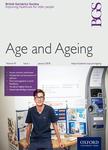版权所有:内蒙古大学图书馆 技术提供:维普资讯• 智图
内蒙古自治区呼和浩特市赛罕区大学西街235号 邮编: 010021

作者机构:School of Allied Health Ageing Research Centre Health Research Institute University of Limerick Ireland Department of Sport Exercise and Nutrition School of Science and Computing Atlantic Technological University ATU Galway City Ireland Trinity Institute of Neurosciences Trinity College Dublin Ireland Data Science Centre and Department of General Practice Royal College of SurgeonsIreland Dublin 2 School of Pharmacy and Biomolecular Sciences Royal College of SurgeonsIreland Dublin 2
出 版 物:《Age and Ageing》 (年龄与衰老)
年 卷 期:2023年第52卷第Supplement_1期
页 面:afac322.046-afac322.046页
学科分类:1002[医学-临床医学] 100201[医学-内科学(含:心血管病、血液病、呼吸系病、消化系病、内分泌与代谢病、肾病、风湿病、传染病)] 10[医学]
摘 要:Introduction Acute healthcare use varies by age, with older adults the highest users of most acute healthcare services. International reports have highlighted increased use of Emergency Department (ED) services by older adults. Older adults who visit the ED may be admitted to hospital or discharged home and are vulnerable to adverse outcomes including cognitive decline, falls, readmission, mortality and hospital acquired limitations in activities of daily living. Using data from The Irish Longitudinal Study on Ageing (TILDA), the aim of this study was to investigate the impact of acute healthcare utilisation at baseline on subjective and objective measures of function at four-year follow-up in older *** This study represents a secondary analysis of a prospective cohort study where data from Wave 1 (baseline) and Wave 3 (four-year follow up) of TILDA were analysed in conjunction with a public and patient involvement group of older adults. Acute healthcare utilisation was defined as an ED visit with or without hospitalisation in the previous 12 months. Function was assessed objectively using Timed-Up-and Go (TUG) and grip strength and subjectively using self-report limitations in activities of daily living and instrumental activities of daily *** A total of 1516 participants met the study inclusion criteria. Mean age was 70.9 years (SD=4.6) and 48% were male. At baseline, 1280 participants reported no acute healthcare use. 118 indicated an ED visit but no hospitalisation in the previous twelve months and 118 reported both an ED visit and hospitalisation. Adjusting for all covariates, compared to those with no acute healthcare utilisation, those with an ED visit with no hospital admission had poorer TUG performance at follow up (β= 0.67, 95% CI: 0.34, 1.29, p=0.039).Conclusion The results of this study support a relationship between acute healthcare utilisation and functional decline assessed by TUG at follow-up.